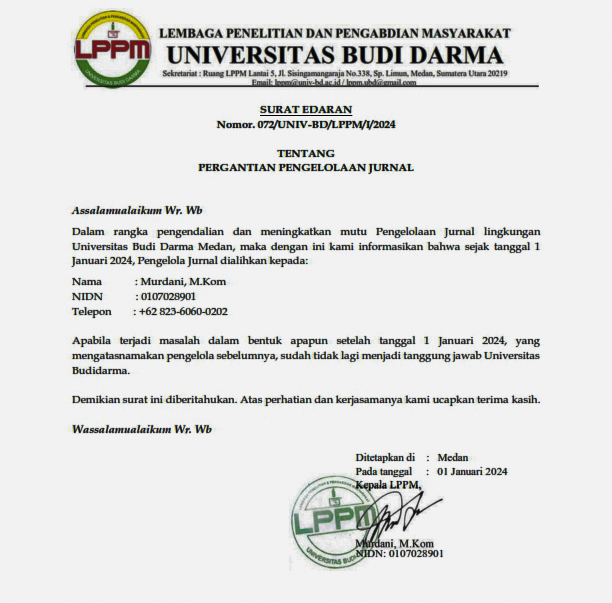Implementasi Algoritma K-Medoids Dengan Evaluasi Davies-Bouldin-Index Untuk Klasterisasi Harapan Hidup Pasca Operasi Pada Pasien Penderita Kanker Paru-Paru
DOI:
https://doi.org/10.30865/json.v3i4.4055Keywords:
Lung Cancer, Data Mining, Clustering, K-Medoids Algorithm, Davies Bouldin IndexAbstract
Lung Cancer is a disease in which there are cells that grow in the lungs by a collection of carcionogens uncontrollably. Lung Cancer can be treated with surgery, chemotherapy and radiotherapy. Early treatment that needs to be done to reduce the mortality rate in patients with lung cancer after performing thoracic surgery, by collecting data from each patients regarding this information causes a new problem, including the data obtained including high-dimensional data and has many attributes so that it can produce less accurate information. So it is necessary to calculate data mining clustering. In general, the methods for performing clustering are grouped into four parts, namely partitioning, hierarchial, grid-based and model-based. This study used the k-medoids algorithm because it is able to handle data sensitive to outliers and has high accuracy and efficiency in processing large numbers objects. The results of the k-medoids calculation were evaluated using the euclidean distance Davies Bouldin Index which resulted in a DBI value of 0.93543 indicating that the k-medoids algoritm achieves good grouping because the final result of the calculation is less than 0. From the results of the evaluation using DBI it shows that the k-medoids algorithm has an average accumulation average at the time of execution is quite fast and the cluster quality is good.ÂReferences
T. Juninda, Mustasim, and E. Andri, “Penerapan Algoritma K-Medoids untuk Pengelompokan Penyakit di Pekanbaru Riau,†Semin. Nas. Teknol. Informasi, Komun. dan Ind., vol. 11, no. 1, pp. 42–49, 2019.
A. D. Andini and T. Arifin, “Implementasi Algoritma K-Medoids Untuk Klasterisasi Data Penyakit Pasien Di Rsud Kota Bandung,†J. RESPONSIF Ris. Sains …, vol. 2, no. 2, pp. 128–138, 2020, [Online]. Available: http://ejurnal.ars.ac.id/index.php/jti/article/view/247.
I. F. Anshori and D. Riana, “Prediksi Harapan Hidup Pasien Kanker Paru-Paru Pasca Operasi Bedah Thoraks Menggunakan Boosted Neural Network Dan Smote,†vol. 6, no. 1, pp. 9–15, 2021.
R. T. Prasetio and S. Susanti, “Prediksi Harapan Hidup Pasien Kanker Paru Pasca Operasi Bedah Toraks Menggunakan Boosted k-Nearest Neighbor,†J. Responsif, vol. 1, no. 1, pp. 64–69, 2019, [Online]. Available: http://ejurnal.univbsi.id/index.php/jti.
Y. A. Setyadi, I. Asror, Y. Firdaus, and A. Wibowo, “Prediksi Harapan Hidup Pasca Operasi Toraks pada Pasien Penderita Kanker Paru-paru Menggunakan Metode Genetic Algorithm untuk Feature Selection dan Naïve Bayes Classifier,†e-Proceeding Eng., vol. 7, no. 2, pp. 8349–8360, 2020.
R. A. Farissa, R. Mayasari, and Y. Umaidah, “Perbandingan Algoritma K-Means dan K-Medoids Untuk Pengelompokkan Data Obat dengan Silhouette Coefficient,†vol. 5, no. 2, pp. 109–116, 2021.
D. Kurmiati, M. Z. Fauzi, Ripangi, A. Falegas, and Indria, “Clustering of Earthquake Prone Areas in Indonesia Using K-Medoids Algorithm,†Malcolm Indones. J. Mach. Learn. Comput. Sci., vol. 1, no. 1, pp. 47–57, 2021, doi: 10.21108/indojc.2019.4.3.359.
I. Syukra, A. Hidayat, and M. Z. Fauzi, “Implementation of K-Medoids and FP-Growth Algorithms for Grouping and Product Offering Recommendations,†Indones. J. Artif. Intell. Data Min., vol. 2, no. 2, p. 107, 2019, doi: 10.24014/ijaidm.v2i2.8326.
R. W. Sembiring Brahmana, F. A. Mohammed, and K. Chairuang, “Customer Segmentation Based on RFM Model Using K-Means, K-Medoids, and DBSCAN Methods,†Lontar Komput. J. Ilm. Teknol. Inf., vol. 11, no. 1, p. 32, 2020, doi: 10.24843/lkjiti.2020.v11.i01.p04.
A. Supriyadi, A. Triayudi, and ..., “Perbandingan Algoritma K-Means Dengan K-Medoids Pada Pengelompokan Armada Kendaraan Truk Berdasarkan Produktivitas,†JIPI (Jurnal …, vol. 06, pp. 229–240, 2021, [Online]. Available: https://www.jurnal.stkippgritulungagung.ac.id/index.php/jipi/article/view/2008.
M. N. P. Pamulang, M. N. Aini, and U. Enri3, “Komparasi Distance Measure Pada K-Medoids Clustering untuk Pengelompokkan Penyakit ISPA,†Edumatic J. Pendidik. Inform., vol. 5, no. 1, pp. 99–107, 2021, doi: 10.29408/edumatic.v5i1.3359.
F. Hardiyanti, H. S. Tambunan, and I. S. Saragih, “Penerapan Metode K-Medoids Clustering Pada Penanganan Kasus Diare Di Indonesia,†KOMIK (Konferensi Nas. Teknol. Inf. dan Komputer), vol. 3, no. 1, pp. 598–603, 2019, doi: 10.30865/komik.v3i1.1666.
P. E. Prakasawati, Y. H. Chrisnanto, and A. I. Hadiana, “Segmentasi Pelanggan Berdasarkan Produk Menggunakan Metode K- Medoids,†KOMIK (Konferensi Nas. Teknol. Inf. dan Komputer), vol. 3, no. 1, pp. 335–339, 2019, doi: 10.30865/komik.v3i1.1610.
S. R. Ningsih, I. S. Damanik, A. P. Windarto, H. S. Tambunan, J. Jalaluddin, and A. Wanto, “Analisis K-Medoids Dalam Pengelompokkan Penduduk Buta Huruf Menurut Provinsi,†Pros. Semin. Nas. Ris. Inf. Sci., vol. 1, no. September, p. 721, 2019, doi: 10.30645/senaris.v1i0.78.
A. Hermawati, S. Jumini, M. Astuti, F. Ismail, and R. Rahim, “Unsupervised Data Mining with K-Medoids Method in Mapping Areas of Student and Teacher Ratio in Indonesia,†TEM J., vol. 9, no. 4, pp. 1614–1618, 2020, doi: 10.18421/TEM94-37.
S. Samudi, S. Widodo, and H. Brawijaya, “The K-Medoids Clustering Method for Learning Applications during the COVID-19 Pandemic,†SinkrOn, vol. 5, no. 1, p. 116, 2020, doi: 10.33395/sinkron.v5i1.10649.
D. A. I. C. Dewi and D. A. K. Pramita, “Analisis Perbandingan Metode Elbow dan Silhouette pada Algoritma Clustering K-Medoids dalam Pengelompokan Produksi Kerajinan Bali,†Matrix J. Manaj. Teknol. dan Inform., vol. 9, no. 3, pp. 102–109, 2019, doi: 10.31940/matrix.v9i3.1662.
M. H. Herviany, S. P. Delima, T. Nurhidayah, and K. Kasini, “Perbandingan Algoritma K-Means dan K-Medoids untuk Pengelompokkan Daerah Rawan Tanah Longsor Pada Provinsi Jawa Barat: Comparison of K-Means and K-Medoids Algorithms for Grouping Landslide Prone Areas in West Java Province,†MALCOM Indones. J. Mach. Learn. Comput. Sci., vol. 1, no. 1, pp. 34–40, 2021.
R. K. Dinata, S. Retno, and N. Hasdyna, “Minimization of the Number of Iterations in K-Medoids Clustering with Purity Algorithm,†Rev. d’Intelligence Artif., vol. 35, no. 3, pp. 193–199, 2021, doi: 10.18280/ria.350302.
M. Herviany, S. P. Delima, T. Nurhidayah, and Kasini, “Perbandingan Algoritma K-Means dan K-Medoids untuk Pengelompokkan Daerah Rawan Tanah Longsor di Provinsi Jawa Barat,†MALCOM Indones. J. Mach. Learn. Comput. Sci., vol. 1, no. 1, pp. 34–40, 2021.
V. V Arganata, “Algoritma Partitioning Around Medoids (Pam) Dengan Metode Davies Bouldin Index Untuk Mengelompokkan Provinsi Di Indonesia …,†2021, [Online]. Available: http://repository.unmuhjember.ac.id/id/eprint/8381.
Y. Religia and R. T. B. Jaya, “Pengelompokan Menggunakan Algoritma K- Medoid Untuk Evaluasi Performa Siswa,†J. Pelita Teknol., vol. 15, no. 1, pp. 49–55, 2020.
F. Farahdinna, I. Nurdiansyah, A. Suryani, and A. Wibowo, “Perbandingan Algoritma K-Means Dan K-Medoids Dalam Klasterisasi Produk Asuransi Perusahaan Nasional,†J. Ilm. FIFO, vol. 11, no. 2, p. 208, 2019, doi: 10.22441/fifo.2019.v11i2.010.
A. A. D. Sulistyawati and M. Sadikin, “Penerapan Algoritma K-Medoids Untuk Menentukan Segmentasi Pelanggan,†Sistemasi, vol. 10, no. 3, p. 516, 2021, doi: 10.32520/stmsi.v10i3.1332.
Downloads
Published
How to Cite
Issue
Section
License

This work is licensed under a Creative Commons Attribution 4.0 International License
Authors who publish with this journal agree to the following terms:
- Authors retain copyright and grant the journal right of first publication with the work simultaneously licensed under Creative Commons Attribution 4.0 International License that allows others to share the work with an acknowledgment of the work's authorship and initial publication in this journal.
- Authors are able to enter into separate, additional contractual arrangements for the non-exclusive distribution of the journal's published version of the work (e.g., post it to an institutional repository or publish it in a book), with an acknowledgment of its initial publication in this journal.
- Authors are permitted and encouraged to post their work online (e.g., in institutional repositories or on their website) prior to and during the submission process, as it can lead to productive exchanges, as well as earlier and greater citation of published work (Refer to The Effect of Open Access).





